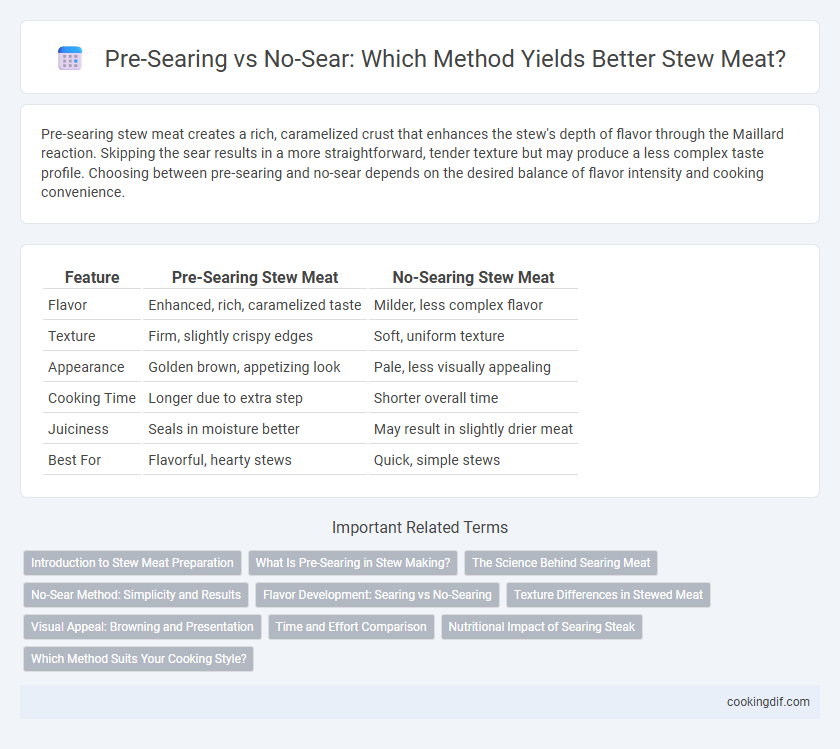Pre-searing stew meat creates a rich, caramelized crust that enhances the stew's depth of flavor through the Maillard reaction. Skipping the sear results in a more straightforward, tender texture but may produce a less complex taste profile. Choosing between pre-searing and no-sear depends on the desired balance of flavor intensity and cooking convenience.
Table of Comparison
| Feature | Pre-Searing Stew Meat | No-Searing Stew Meat |
|---|---|---|
| Flavor | Enhanced, rich, caramelized taste | Milder, less complex flavor |
| Texture | Firm, slightly crispy edges | Soft, uniform texture |
| Appearance | Golden brown, appetizing look | Pale, less visually appealing |
| Cooking Time | Longer due to extra step | Shorter overall time |
| Juiciness | Seals in moisture better | May result in slightly drier meat |
| Best For | Flavorful, hearty stews | Quick, simple stews |
Introduction to Stew Meat Preparation
Stew meat preparation begins with selecting the right cut, often tough but flavorful, such as chuck or round, which benefits from proper cooking techniques. Pre-searing stew meat enhances flavor development through the Maillard reaction, creating a rich, caramelized crust that deepens the stew's overall taste. Skipping the searing step results in a milder flavor profile, relying solely on slow cooking to tenderize the meat and meld flavors.
What Is Pre-Searing in Stew Making?
Pre-searing in stew making involves quickly browning stew meat in a hot pan before simmering to enhance flavor and texture through the Maillard reaction. This process creates a caramelized crust that locks in juices, resulting in richer, more savory stews. Skipping pre-searing may save time but can lead to a less robust flavor and a less appealing meat texture.
The Science Behind Searing Meat
Searing stew meat triggers the Maillard reaction, creating complex flavor compounds that enhance the overall taste and aroma of the stew. This high-temperature cooking method also helps to develop a rich, caramelized crust that locks in juices, improving texture and mouthfeel. Conversely, choosing a no-sear method results in a cleaner, softer flavor profile but may lack the depth and complexity achieved through searing.
No-Sear Method: Simplicity and Results
The no-sear method for stew meat simplifies preparation by eliminating the browning step, reducing overall cooking time and effort. This approach allows the meat to slowly tenderize in the cooking liquid, resulting in a juicy and flavorful stew as the natural juices are retained without the Maillard reaction. Home cooks seeking convenience often prefer no-sear recipes, which deliver rich and satisfying textures with minimal hands-on work.
Flavor Development: Searing vs No-Searing
Pre-searing stew meat creates a Maillard reaction that intensifies flavor by forming rich, caramelized crusts, enhancing the overall taste profile. No-sear methods rely on slow cooking to develop flavors but may result in a less complex, milder taste due to the absence of initial browning. Choosing pre-searing leads to deeper, more robust flavors, while no-sear techniques emphasize tenderness over intense flavor complexity.
Texture Differences in Stewed Meat
Pre-searing stew meat enhances texture by creating a caramelized crust that adds depth and firmness to each bite, preventing the meat from becoming mushy during slow cooking. No-sear methods result in softer, more tender meat but may lack the complex surface flavors and slight chewiness that searing imparts. Choosing pre-searing influences the final mouthfeel by balancing tenderness with a desirable crust, while no-sear yields uniformly tender but less textured stew meat.
Visual Appeal: Browning and Presentation
Pre-searing stew meat enhances visual appeal by creating a rich, caramelized crust through the Maillard reaction, which adds depth of color and texture to the dish. Unseared meat tends to appear pale and lacks the glossy, appetizing surface that browned meat provides. This contrast significantly improves the overall presentation, making the stew more visually enticing and restaurant-quality.
Time and Effort Comparison
Pre-searing stew meat significantly reduces cooking time by creating a flavorful crust that helps lock in juices and accelerate browning during simmering. In contrast, no-sear methods save initial preparation effort but require longer cooking times to develop depth of flavor and tenderize the meat fully. Choosing pre-searing balances upfront effort with shorter overall cooking duration, enhancing both texture and taste efficiency.
Nutritional Impact of Searing Steak
Pre-searing stew meat enhances flavor through the Maillard reaction without significantly altering the meat's nutritional content but can slightly reduce moisture retention. Opting out of searing preserves more of the meat's natural juices, potentially retaining marginally higher protein concentration and vitamins like B12. Both methods maintain essential nutrients, but searing may improve taste while minimally affecting nutrient density.
Which Method Suits Your Cooking Style?
Pre-searing stew meat enhances flavor through the Maillard reaction, creating a rich, caramelized crust that deepens the stew's taste. No-sear methods save time and simplify preparation, allowing the meat to tenderize naturally while soaking up the stew's broth and spices. Choosing between pre-searing and no-sear depends on your preference for robust flavor development versus convenience and ease in cooking.
Pre-searing vs no-sear for stew meat Infographic

 cookingdif.com
cookingdif.com